Westminster Bridge
Westminster Bridge is a road-and-foot-traffic bridge over the River Thames in London, linking Westminster on the west side and Lambeth on the east side.
Westminster Bridge | |
|---|---|
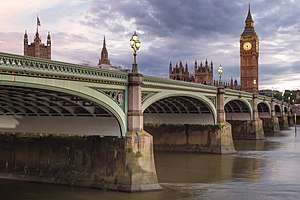 | |
| Coordinates | 51°30′03″N 0°07′19″W[1] |
| Carries | A302 road |
| Crosses | River Thames |
| Locale | London |
| Heritage status | Grade II* listed structure |
| Preceded by | Lambeth Bridge |
| Followed by | Hungerford Bridge and Golden Jubilee Bridges |
| Characteristics | |
| Design | Arch bridge |
| Total length | 820 feet (250 m) |
| Width | 85 feet (26 m) |
| No. of spans | 7 |
| History | |
| Designer | Thomas Page |
| Opened | (first bridge) 18 November 1750 (second bridge) 24 May 1862 |
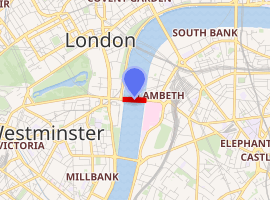
| |
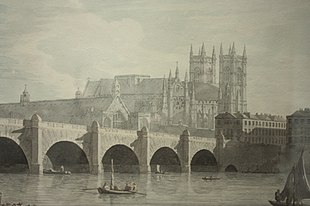
The bridge is painted predominantly green, the same colour as the leather seats in the House of Commons which is on the side of the Palace of Westminster nearest to the bridge, but a natural shade similar to verdigris. This is in contrast to Lambeth Bridge, which is red, the same colour as the seats in the House of Lords and is on the opposite side of the Houses of Parliament.[2]
In 2005–2007, it underwent a complete refurbishment, including replacing the iron fascias and repainting the whole bridge. It links the Palace of Westminster on the west side of the river with County Hall and the London Eye on the east and was the finishing point during the early years of the London Marathon.
The next bridge downstream is the Hungerford footbridge and upstream is Lambeth Bridge. Westminster Bridge was designated a Grade II* listed structure in 1981.[3]
History
For over 600 years (at least 1129–1729), the nearest Thames bridge to London Bridge was at Kingston. From late Tudor times congestion in trading hours at London Bridge (for road goods and carriages from Kent, Essex, much of Surrey, Middlesex and beyond) often amounted to more than an hour.[4] A bridge at Westminster was proposed in 1664, but opposed by the Corporation of London and the watermen. Further opposition held sway in 1722. However an intervening bridge (albeit in timber) was built at Putney in 1729 and the scheme received parliamentary approval in 1736. Financed by private capital, lotteries and grants, Westminster Bridge was built between 1739–1750, under the supervision of the Swiss engineer Charles Labelye.[5] The bridge opened on 18 November 1750.[6]
The City of London responded to Westminster Bridge and the population growth by removing the buildings on London Bridge and widening it in 1760–63. With Putney Bridge, the bridge paved the way for four others within three decades: Blackfriars Bridge (1769, built by the City), Kew Bridge (1759), Battersea Bridge (1773), and Richmond Bridge (1777) by which date roads and vehicles were improved and fewer regular goods transported by water.
The bridge assisted the expanding West End to the developing South London as well as goods and carriages from the more estuarine counties and the East Sussex and Kentish ports. Without the bridge, traffic to and from the greater West End would have to negotiate streets often as congested as London Bridge, principally the Strand/Fleet Street and New Oxford Street/Holborn. Roads on both sides of the river were also built and improved, including Charing Cross Road and around the Elephant & Castle in Southwark.
By the mid-19th century the bridge was subsiding badly and expensive to maintain. The current bridge was designed by Thomas Page and opened on 24 May 1862.[7] With a length of 820 feet (250 m) and a width of 85 feet (26 m),[8] it is a seven-arch, cast-iron[9] bridge with Gothic detailing by Charles Barry (the architect of the Palace of Westminster). Since the removal of Rennie's New London Bridge in 1967 it is the oldest road structure which crosses the Thames in central London.
On 22 March 2017, a terrorist attack started on the bridge and continued into Bridge Street and Old Palace Yard. Five people – three pedestrians, one police officer, and the attacker – died as a result of the incident. A colleague of the officer (who was stationed nearby) was armed and shot the attacker. More than 50 people were injured. An investigation is ongoing by the Metropolitan Police.[10]
Image gallery
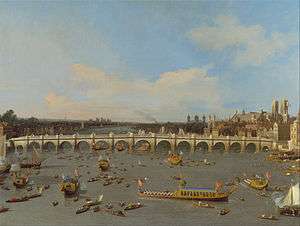 The first Westminster Bridge as painted by Canaletto, 1747. Yale Center for British Art, New Haven.
The first Westminster Bridge as painted by Canaletto, 1747. Yale Center for British Art, New Haven.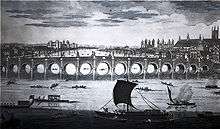 Westminster Bridge, around 1750. The proprietors of the bridge had to pay compensation to the operators of the earlier 'Horseferry', and to local watermen
Westminster Bridge, around 1750. The proprietors of the bridge had to pay compensation to the operators of the earlier 'Horseferry', and to local watermen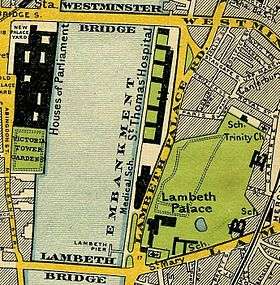 1897 map, showing Lambeth Palace, Lambeth Bridge, the Houses of Parliament and Westminster Bridge
1897 map, showing Lambeth Palace, Lambeth Bridge, the Houses of Parliament and Westminster Bridge.png) Westminster & Lambeth, 1746. Westminster Bridge, opened in 1740, connects Westminster to Lambeth; Huntley Ferry crosses the river on the site of the future Vauxhall Bridge
Westminster & Lambeth, 1746. Westminster Bridge, opened in 1740, connects Westminster to Lambeth; Huntley Ferry crosses the river on the site of the future Vauxhall Bridge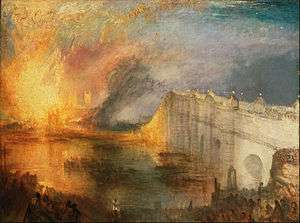 The Burning of the Houses of Lords and Commons by J. M. W. Turner, 1835, with Westminster Bridge on the right
The Burning of the Houses of Lords and Commons by J. M. W. Turner, 1835, with Westminster Bridge on the right Street lamps on the bridge
Street lamps on the bridge The coats of arms of Queen Victoria and Albert, Prince Consort on the bridge
The coats of arms of Queen Victoria and Albert, Prince Consort on the bridge The coat of arms of Henry John Temple, 3rd Viscount Palmerston on the bridge. Palmerston was Prime Minister when the current bridge was opened.
The coat of arms of Henry John Temple, 3rd Viscount Palmerston on the bridge. Palmerston was Prime Minister when the current bridge was opened. Westminster Bridge By-Laws Notice
Westminster Bridge By-Laws Notice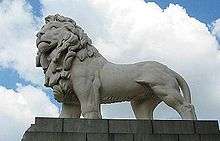 The South Bank Lion at the east end of Westminster Bridge
The South Bank Lion at the east end of Westminster Bridge
In popular culture
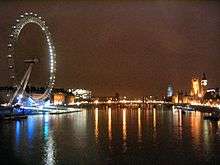

- In the 1964 Doctor Who serial The Dalek Invasion of Earth, the Daleks are seen moving across it in the 22nd Century.
- In the 2002 British horror film 28 Days Later, the protagonist awakes from a coma to find London deserted and walks over an eerily empty Westminster Bridge whilst looking for signs of life.
- Westminster Bridge is the start and finish point for the Bridges Handicap Race, a traditional London running race.
- William Wordsworth wrote the sonnet Composed upon Westminster Bridge, September 3, 1802.
- In the finale of the 24th James Bond film Spectre, Blofeld's helicopter crashes into Westminster Bridge.
References
- National Heritage List for England, Wikidata Q6973052
- Becky Jones,Clare Lewis (2012). The Bumper Book of London: Everything You Need to Know About London and More... Frances Lincoln. p. 127. ISBN 978 1 781011 03 4.
- Historic England. "Details from listed building database (1081058)". National Heritage List for England. Retrieved 27 November 2008.
- Pierce, Patricia, Old London Bridge – The Story of the Longest Inhabited Bridge in Europe, Headline Books, 2001, ISBN 0-7472-3493-0 at p.45
- Walker, R. J. B. (1979). Old Westminster Bridge: The Bridge of Fools. Newton Abbot: David & Charles. ISBN 978-0715378373.
- Cookson, Brian (October 2010). "Westminster Bridge" (PDF). London Historians. Retrieved 15 August 2017.
- John Eade. "Where Thames Smooth Waters Glide". Thames.me.uk. Retrieved 28 November 2011.
- Thames Tideway Tunnel (September 2013). "Tunnel and Bridge Assessments: Central Zone: Westminster Bridge" (PDF). Thames Water Utilities. p. 4. Retrieved 13 May 2015.
- "Westminster Bridge | British History Online". www.british-history.ac.uk. Retrieved 1 April 2017.
- "London attack: What we know so far". BBC News. BBC. 27 March 2017. Retrieved 27 March 2017.
External links
| Wikimedia Commons has media related to Westminster Bridge. |
- Westminster Bridge (1750) at Structurae
- Westminster Bridge (1862) at Structurae
- Interactive Panorama: Westminster Bridge